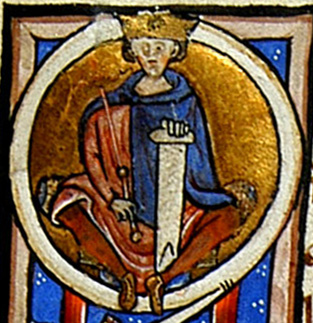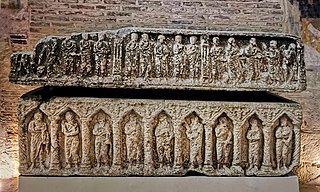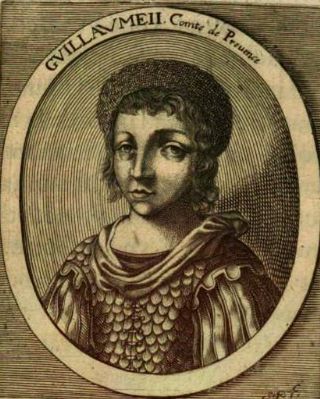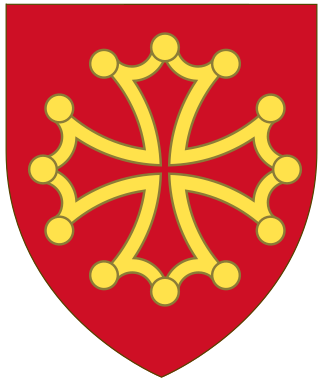
Alfonso Jordan, also spelled Alfons Jordan or Alphonse Jourdain (1103–1148), was the Count of Tripoli (1105–09), Count of Rouergue (1109–48) and Count of Toulouse, Margrave of Provence and Duke of Narbonne (1112–48).

The County of Toulouse was a territory in southern France consisting of the city of Toulouse and its environs, ruled by the Count of Toulouse from the late 9th century until the late 13th century.

Rudolph, sometimes called Ralph, was the king of France from 923 until his death in 936. He was elected to succeed his father-in-law, Robert I, and spent much of his reign defending his realm from Viking raids.
Otto-William was count of Mâcon, Nevers, and Burgundy.
The count of Toulouse was the ruler of Toulouse during the 8th to 13th centuries. Originating as vassals of the Frankish kings, the hereditary counts ruled the city of Toulouse and its surrounding county from the late 9th century until 1270. The counts and other family members were also at various times counts of Quercy, Rouergue, Albi, and Nîmes, and sometimes margraves of Septimania and Provence. Count Raymond IV founded the Crusader state of Tripoli, and his descendants were also counts there. They reached the zenith of their power during the 11th and 12th centuries, but after the Albigensian Crusade the county fell to the kingdom of France, nominally in 1229 and de facto in 1271.
The County of Carcassonne was a medieval fiefdom controlling the city of Carcassonne, France and its environs. It was often united with the County of Razès.
Sancho IV Garcés was the duke of Gascony from 930 until his death. During his tenure, Gascony shrank considerably as his brothers inherited important regions and the de facto and perhaps de jure independent duchy slipped into historical near-oblivion.

William III Taillefer was the Count of Toulouse, Albi, and Quercy, as well as the Marquis of Gothie from 972 or 978 to his death. He was the first of the Toulousain branch of his family to bear the title marchio, which he inherited from Raymond II of Rouergue.

William II, called the Pious, was the Count of Provence.
Adelaide-Blanche of Anjou(c. 940 –1026) was, by her successive marriages, countess of Gévaudan and Forez, of Toulouse, of Provence, and of Burgundy, and queen of Aquitaine. She was the regent of Gevaudan during the minority of her sons in the 960s, and the regent of Provence during the minority of her son from 994 until 999.
Raymond Pons, who may be numbered Raymond III or Pons I, was the count of Toulouse from 924.
Odo was the count of Toulouse from 872 to 918 or 919, when he died.
Raymond II was the Count of Toulouse, Nîmes, and Albi. He was the, probably elder, son of Odo of Toulouse and Garsenda.
Hugh may be the name of a Count of Toulouse, Nîmes, Quercy, and Albi in the third quarter of the 10th century, and perhaps identical to a Bishop Hugh. He was the son of Raymond III, Count of Toulouse and probably grandson of Raymond Pons.
The title Prince of Gothia or Prince of the Goths was a title of nobility, sometimes assumed by its holder as a sign of supremacy in the region of Gothia and sometimes bestowed by the sovereign of West Francia to the principal nobleman in the south of the realm, in the ninth and tenth centuries. Sometimes hereditary and sometimes not, the title has been rendered in English as Dukeof Septimania or Dukeof Gothia. A similar or the same "office" was often held with the title comes marcæ Hispanicæ: "Count of the Spanish March." The title was also a chronicler's device and, as presented in some chronicles, may never have been used in any official capacity.
The County of Rodez was a fief of the County of Toulouse formed out of part of the old County of Rouergue in what is today Aveyron, France. Its capital was Rodez. At its height, it was a centre of troubadour culture.
The County of Melgueil was a fief of first the Carolingian Emperor, then the King of France, and finally (1085) the Papacy during the Middle Ages. Counts probably sat at Melgueil from the time of the Visigoths. The counts of Melgueil were also counts of Maguelonne and Substantion from at least the time of Peter's homage to Pope Gregory VII on 27 April 1085. In 1172 Beatriu disinherited her son Bertrand and named her daughter Ermessenda her heiress. Later that year Ermessenda married the future Raymond VI of Toulouse and by her will of 1176 the county was to go to Toulouse. Bertrand refused to recognise his disinheritance and pledged homage as Count of Melgueil to Alfonso II of Aragon in 1172. The county fell to the Toulouse in 1190 and was annexed to the French crown in 1213, during the Albigensian Crusade. At the Fourth Council of the Lateran in 1215 it was given to the Diocese of Maguelonne and secular and ecclesiastical authority were merged.

The House of Toulouse, sometimes called House of Saint-Gilles or Raimondines, is the name of the dynasty that ruled the County of Toulouse.